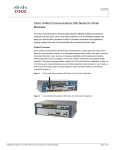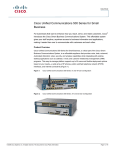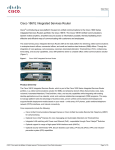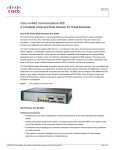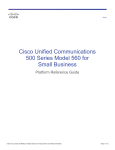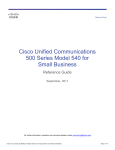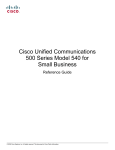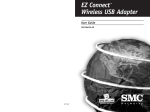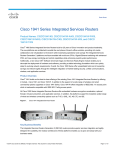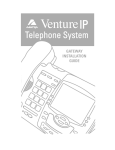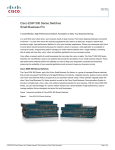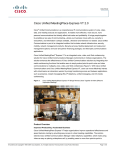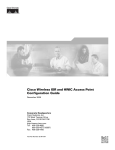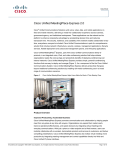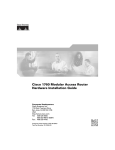Download Cisco 8U CME Base CUE+Phone FL w/4FXO 1VIC
Transcript
Data Sheet Cisco Unified Communications 500 Series for Small Business ® Cisco Unified Communications Solutions unify voice, video, data, and mobile applications on fixed and mobile networks, delivering a media-rich collaboration experience across business, government agency, and institutional workspaces. These applications use the network as the platform to enhance comparative advantage by accelerating decision time and reducing transaction time. The security, resilience, and scalability of the network enable users in any workspace to easily connect anywhere, anytime, and anyplace, using any media, device or operating system. Cisco Unified Communications is part of a comprehensive solution that includes network infrastructure, security, wireless, management applications, lifecycle services, flexible deployment and outsourced management options, and third-party applications. For small businesses wanting to reach, serve, and retain customers, Cisco introduces the Cisco Smart Business Communications System, a new, affordable system that makes anytime, anywhere highly secure access to information possible, thereby facilitating more effective and efficient ways of communicating with customers and employees. Product Overview Cisco Unified Communications 500 Series for Small Business, a critical part of the Cisco Smart Business Communications System, is a unified communications appliance for small businesses that provides voice, data, voicemail, Automated Attendant, video, security, and wireless capabilities while integrating with existing desktop applications such as calendar, e-mail, and customer relationship management (CRM) programs. This easy-to-manage platform uses business-class, proven unified communications technologies to support up to 50 users, and supports flexible deployment models based on your needs—a wide array of IP phones, public switched telephone network (PSTN) interfaces, and Internet connectivity (Figure 1). Figure 1. Cisco Unified Communications 500 Series—8/16 User Configuration Figure 2. Cisco Unified Communications 500 Series—32/48 User Configuration All contents are Copyright © 2007 Cisco Systems, Inc. All rights reserved. This document is Cisco Public Information. Page 1 of 16 Data Sheet Core components of the Cisco Unified Communications 500 Series include: ● Cisco Unified IP phones, including wireless handsets and Session Initiation Protocol (SIP) phones ● Cisco Unified Communications Manager Express for call processing ● Cisco Unity Express for voice messaging and Automated Attendant ● Support for Cisco Unified CallConnectors for integration with Windows PC applications ● LAN switching: Integrated Power over Ethernet (PoE) switch, and ability to expand through ® ® Cisco Catalyst Express 520 Series Switches ● Firewall and VPN capabilities ● Optional integrated wireless LAN (WLAN) capability on some models or external access points and Cisco Wireless LAN Controller Modules ● Cisco Configuration Assistant for GUI-based customization of the solution ● Optional remote system monitoring capabilities Cisco Unified IP Phones Cisco provides a complete range of Cisco Unified IP phones and communications devices designed to take full advantage of converged voice and data networks, and these devices offer the convenience and user friendliness found in business phones. Cisco Unified IP phones can help improve productivity by meeting the needs of different users throughout your organization. The Cisco Unified IP phone portfolio provides the following: ● IP phones with LCD displays, including dynamic soft keys for call features and functions ● Support for information services, including Extensible Markup Language (XML) capabilities to extend IP phone systems to give IP phone users access to a variety of information such as stock quotes, employee directories, and Web-based content Cisco Unified IP phones lead the IP communications device market and provide a complete IP phone system portfolio with ease of use, excellent audio quality, increased accessibility for people with disabilities, ergonomic physical design, advanced services, and features. The IP phone portfolio includes options for use from wherever you are: the company lobby, the manufacturing floor, the executive suite, at home, on the road, or in a branch office (Figure 3). Figure 3. Cisco Unified IP Phone Portfolio All contents are Copyright © 2007 Cisco Systems, Inc. All rights reserved. This document is Cisco Public Information. Page 2 of 16 Data Sheet Cisco Unified Communications Manager Express ® Cisco Unified Communications Manager Express is a Cisco IOS Software solution embedded in the Cisco Unified Communications 500 Series appliance that provides call processing for Cisco Unified IP phones. Simple to deploy, administer, and maintain, Cisco Unified Communications Express is a reliable, feature-rich telephony solution. Cisco Unity Express Embedded Cisco Unity Express helps enable voicemail, desktop messaging, and AutomatedAttendant services for increased customer service and rich employee communications experience. Cisco Unified CallConnectors for Windows PC Applications The Cisco Unified Communications 500 Series integrates with common Windows desktop applications to give small business owners access to productivity gains once available only to large businesses. With Cisco Unified CallConnectors, you can integrate your Cisco Unified IP phones with common applications, including Microsoft Outlook, Internet Explorer, Microsoft Dynamics CRM, or Salesforce.com CRM. LAN Switching and Routing The Cisco Unified Communications 500 Series has an integrated, managed Ethernet switch that provides 8 ports of 10/100 PoE optimized for integration with the Cisco Smart Business Communications System. Additionally, the system capacity can be expanded by connecting the recommended Cisco Catalyst Express 520 Series Switch. Providing 8 to 24 additional ports of 10/100 PoE, the Cisco Catalyst Express 520 Series Switch ships with a predefined software configuration to work immediately with the Cisco Unified Communications 500 Series for Small Business. The Cisco Unified Communications 500 Series supports static routing and routing between VLANs and the built-in interfaces. All contents are Copyright © 2007 Cisco Systems, Inc. All rights reserved. This document is Cisco Public Information. Page 3 of 16 Data Sheet Firewall for Network Security Security is a fundamental element of any network, and Cisco products play an important role in embedding security at the customer’s access edge. The Cisco IOS Firewall is a stateful-inspection firewall available with the Cisco Unified Communications 500 Series. Built from market-leading ® Cisco PIX Firewall technologies, Cisco IOS Firewall is a base feature on the Cisco Unified Communications 500 Series platform; it is ideal for protecting the WAN entry point into the network. Virtual Private Networking VPNs carry private data over a public network and extend remote access to users over a shared infrastructure. Maintaining the same security and management policies as private networks, VPNs are the most cost-effective means of establishing point-to-point connection between remote users and a central network. VPNs have been the fastest-growing form of network connectivity, and Cisco takes this approach to a new level by making VPN functions an integral part of the Cisco Unified Communications System. The Cisco Unified Communications 500 Series includes built-in hardware-based encryption acceleration that offloads IP Security (IPsec), Advanced Encryption Standard (AES), Data Encryption Standard (DES), and Triple DES (3DES) encryption and VPN processes to provide increased VPN throughput on the Cisco Unified Communications 500 Series platform. Wireless Mobility Services The 8- and 16-user models of the Cisco Unified Communications 500 Series support an optional integrated WLAN access point for secure WLAN connectivity. As part of the Cisco Smart Business Communications System, the Cisco Unified 500 Series also supports external access points—the Cisco 521 Wireless Express Access Point—and for best-in-class wireless mobility the Cisco 526 Wireless Express Mobility Controller can be added to create a unified system of access points. Small businesses can easily extend access to data applications as well as WLAN telephony. Wireless services allow greater mobility for employees, partners, and customers, resulting in increased productivity. Note: The 32- and 48-user models of the Cisco Unified Communications 500 Series do not support an optional integrated WLAN access point. These models can use the Cisco 521 Wireless Express Access Point and the Cisco 526 Wireless Express Mobility Controller to enable WLAN functions. Cisco Configuration Assistant The Cisco Configuration Assistant, a PC-based, intuitive GUI configuration tool, is an integral component of the Cisco Smart Business Communications System. With a focus on ease of use, the Cisco Configuration Assistant simplifies configuration of multiple technologies—unified communications, switching, routing, security, and wireless. Cisco Configuration Assistant simplifies telephony configuration and provides follow-up support to facilitate easy modification. Features include an interactive topology view, front-panel views of devices, and drag-and-drop Cisco IOS Software upgrades (Figure 4). Figure 4. Cisco Configuration Assistant Configuration Tool All contents are Copyright © 2007 Cisco Systems, Inc. All rights reserved. This document is Cisco Public Information. Page 4 of 16 Data Sheet Architecture Features and Benefits The Cisco Unified Communications 500 Series integrates voice, data, video, security, wireless, and management into one platform. It brings unified communications to small businesses and organizations by providing a simplified, affordable solution that is easy to configure, deploy, and manage. By combining call control, messaging, and mobility into one device, the Cisco Unified Communications 500 Series eliminates the added costs of multiple servers and provides a solution that is easy to set up and manage at a lower price point. Table 1 summarizes the features and benefits of the Cisco Unified Communications 500 Series. Table 1. Platform Features and Benefits Feature Benefit Solution packaging The solution offers various fixed configurations, eliminating the guesswork from configuration. Each configuration is equipped with the appropriate number of feature licenses for call processing, voicemail, and Cisco Unified IP phones, simplifying the product structure. A modular slot is available in most of the configurations, allowing expansion of the system with additional PSTN or analog station interfaces. The appropriate number of fixed digital signal processors (DSPs) is packaged with each configuration. Default system configuration Although packaged to support various deployment configurations, the solution comes with a Cisco Smart Assist predefined configuration from the factory, allowing for rapid deployment of the product in the field: ● Preassigned phone extensions ● Dial plan ● Voice and data VLANs ● Firewall settings With the appropriate licensed base platform, expanding the system is easy; simply connect the companion Cisco Catalyst Express 520 Switch and connect phones to the new PoE Ethernet ports. All contents are Copyright © 2007 Cisco Systems, Inc. All rights reserved. This document is Cisco Public Information. Page 5 of 16 Data Sheet Integrated voicemail and Automated Attendant Voice messaging raises the level of professionalism, productivity, and customer service available to small business customers with built-in Automated-Attendant and advanced voicemail capabilities. With Professional Automated Attendant, all calls can be handled efficiently and reliably 24 hours a day. Callers can dial by extension number of the group or person they are trying to reach or use the Dial-by-Name feature when they do not know a specific extension. Voicemail extends your organization’s productivity by allowing employees to access messages at any time from any telephone. Both internal and external calls to a busy or unattended phone are forwarded to the user’s voicemail box and are greeted with the user’s personalized greeting. Integrated messaging allows you to check your voicemail using Internet Mail Access Protocol (IMAP) email clients, including Microsoft Outlook, Outlook Express, or Lotus Notes. You can also access voicemail features using the XML display on Cisco Unified IP phones. Ethernet connectivity with quality of service (QoS) Ethernet connectivity is provided for IP phones or wireless access points by PoE ports that provide connectivity speeds for up to 100BASE-T Ethernet technology without the need for additional power modules. Most Cisco Unified IP phones include a 10/100 switch with QoS to provide PC desktop connectivity to the network. Optimized QoS is provided for IP phone and desktop configurations. The QoS level helps ensure that voice over IP (VoIP) traffic takes precedence. Voice and data traffic have separate VLANs. Port security limits unauthorized access to the network. Power failover A power failover feature on the base configuration allows access to the PSTN line if a power outage occurs. When power is lost, the first foreign exchange office (FXO) PSTN trunk is directly connected to foreign exchange station (FXS) analog port, allowing for calls to be placed and received. Recorded announcements for callers: Music on Hold (MOH) The process for providing customized MOH announcements is simplified with a dedicated MOH port, allowing small-business owners to play recorded announcements to their callers by simply plugging the audio source into the provided 3.5-mm mini-jack. You can use wave files stored on flash memory. MOH is an audio stream that is played to PSTN and VoIP G.711 or G.729 callers who are placed on hold, reassuring the callers that they are still connected to the called party. Deployment options Depending on the configuration, the Cisco Unified Communications 500 Series can be deployed as a desktop unit, wall-mounted, or installed in a standard 19-inch (48.26-cm) rack with an optional rack-mount kit. Cisco Unified Communications Features IP telephony is currently experiencing tremendous growth, accelerated by access to value-added features and applications that only IP telephony can provide to the end user. Additionally, the cost benefits of converging data, voice, and video on a single network are adding to the rapid acceptance of this technology. Because it is integrated into a single system, Cisco Unified Communications 500 Series for Small Business enhances the advantages of convergence by offering the following benefits: ● Cost-effective operations through a single, integrated voice-and-data platform for all smalloffice needs: This highly reliable platform provides robust QoS and the right level of security, encryption, and firewall to deliver enhanced VPN services to meet small-business needs. The system delivers integrated IP telephony, voicemail, and Automated-Attendant functions, allowing you to deploy one device to address all your business needs—thereby simplifying management, maintenance, and operations and delivering a lower total cost of ownership (TCO). ● Sophisticated key system and private branch exchange (PBX) capabilities: Small businesses have different workflows and require specialized features to support their work practices. The Cisco Unified Communications 500 Series delivers a robust set of telephony features for the small office and delivers unique, value-added capabilities through XML. These capabilities, which cannot be delivered by traditional systems, enhance the productivity of the end user and the business. All contents are Copyright © 2007 Cisco Systems, Inc. All rights reserved. This document is Cisco Public Information. Page 6 of 16 Data Sheet ● Remote maintenance and troubleshooting: You can use the industry-standard Cisco IOS Software command-line interface (CLI) or user-friendly GUI to configure and administer the Cisco Unified Communications 500 Series system. The Cisco Unified Communications 500 Series appliance offers the feature set available with Cisco Unified Communications Manager Express 4.2 and Cisco Unity Express 2.3. Table 2 summarizes the unified communications features. Table 2. Cisco Unified Communications 500 Series for Small Business Features Feature End-user phone features Description ● Multiline appearances on phone ● Attendant console functions using Cisco Unified IP Phone Expansion Module 7914 or PC-based attendance console ● Fast Transfer: Blind or consult ● Busy Lamp Field ● Silent ringing options ● Automatic line selection for outbound calls ● Call Forward on Busy, No Answer, and All ● Call Forward All restriction control ● Do Not Disturb (DND) ● Feature ring with DND set ● IP phone display of DND state ● Dial-plan pattern load on SIP phones ● Diversion of calls directly to voicemail ● Customization of soft keys ● Enable and disable Call Waiting notification per line ● Call Waiting with overlay Directory Number ● Call Waiting Ring ● Dual line appearances per button ● After-hours toll-bar override ● Auto-answer with headset ● European date formats ● Hook flash passthrough across analog PSTN trunks ● Idle URL: Periodically pushes messages or graphics on IP phones ● Last Number Redial ● Local Name Directory Lookup ● On-Hook Dialing ● Station Speed Dial with configuration changes from IP phone ● System Speed Dial for 10,000 numbers ● Silent and Feature Ring options ● SIP-based Line-Side Subscribe, providing basic presence of phone status ● Access features using soft keys or feature access codes ● Remote teleworker IP phone support ● Dynamic Hunt-Group Join or Leave ● Support for fax machines on FXS ports using H.323, Skinny Client Control Protocol (SCCP), and SIP ● XML application services on Cisco Unified IP phone displays ● Station-to-station video telephony using Cisco Unified Video Advantage or Cisco Unified IP Phone 7985G endpoints All contents are Copyright © 2007 Cisco Systems, Inc. All rights reserved. This document is Cisco Public Information. Page 7 of 16 Data Sheet PSTN interfaces and features ● Analog FXO Loop and Ground Start ● Basic Rate Interface (BRI) support for several switch types currently supported in Cisco IOS Software ● T1/E1 for PSTN Connectivity ● Caller ID name and number ● Automatic Number Identification (ANI) ● Direct inward dialing (DID) ● Direct outward dialing ● Dedicated trunk mapping to phone button ● H.323 trunks with H.450 support ● H450.12 automatic detection of H.450 support for remote H.323 endpoints ● H.323-to-H.323 Hairpin Call Routing for non-H.450-compliant H.323 endpoints ● SIP trunks and RFC 2833 support ● Transcoding G.711 and G.729a System calling features ● Account codes and call detail record (CDR) field entry ● Callback Busy Subscriber Camp-On ● Per-phone call coverage rules ● Call Hold and Retrieve ● Call Park: Personal and directed ● Call Park Recall ● Call Park Assign to Extension ● Call Pickup Directed ● Call Pickup Local Group ● Call Pickup Explicit Group ● Call Transfer: Consultative and blind ● Call Waiting ● Eight-party impromptu conferencing ● Computer telephony integration (CTI) with Microsoft Dynamics CRM, Outlook, or Salesforce.com CRM using Cisco IOS Software Telephony Services Provider (TSP) ● Directory services using XML ● Hunt groups: Sequential, circular, and longest idle ● Hunt-group dynamic log in and log out ● Hunt-groups statistics: Daily and hourly ● Intercom ● Meet-Me Conferencing ● MOH: Internal or external source ● Night Service Bell or Call Forwarding ● Overlay extensions for enhanced call coverage ● Called-name display for overlay extensions ● Paging: Internal through IP phones or to external system ● Per-call caller ID blocking ● Secondary dial tone ● Additional system speed-dial option through XML service ● Time-of-day and day-of-week call blocking ● Customizable called-name display ● Basic automatic call distributor (B-ACD) (three queues) with Automated Attendant and call statistics ● Display of number of calls in queue on IP phone ● Agent log in and log out of B-ACD hunt group ● Secure voice IP phone certificate authentication and provisioning plus secure device signaling using Transport Layer Security (TLS) ● For additional information about Cisco Unified Communications Manager Express features, please visit http://www.cisco.com/go/ccme. All contents are Copyright © 2007 Cisco Systems, Inc. All rights reserved. This document is Cisco Public Information. Page 8 of 16 Data Sheet Voice messaging ● Integrated voicemail and Automated-Attendant solution using Cisco Unity Express ● Complete yet concise telephony user interface (TUI) tutorial: Takes the user step by step through the mailbox setup process, minimizing the need for administrator assistance, saving time and money ● Full range of commonly used voicemail features ● Comprehensive voicemail feature set: Replying, forwarding, saving messages; message tagging for privacy or urgency; alternate greetings; pause, fast forward, and rewind; and envelope information ● Networking: Voice Profile for Internet Mail (VPIM) protocol to communicate with other Cisco messaging platforms ● Distribution lists and broadcast messages ● Public and private distribution list function and broadcast messaging capability ● General-delivery mailboxes (GDMs) ● Multiple GDM voicemail boxes for designated team members ● Ability for subscribers to recover a message if it is inadvertently deleted ● Ability to share the user interface, menu structure, and commands with other Cisco voice messaging products ● Personal operator: Configurable alternate telephone number (per voice mailbox) for “zero out” option ● Voicemail access using IMAP integration with Microsoft Outlook, Outlook Express, or Lotus Notes ● Cisco Unified IP phone voicemail and mailbox settings access using Cisco Unity Express VoiceView Express XML application ● For additional information about voicemail features, please visit http://www.cisco.com/go/cue. Automated Attendant ● Up to five Automated-Attendants per system ● Standard dial-by-name and dial-by-extension Automated Attendant ● Holiday schedules and calendar ● Business-hours schedule ● Script editor: Graphical scripting tool that creates customized Automated-Attendant menu flows ● Support for time-of-day and day-of-week routing ● Unlimited menu items and unlimited nesting ● Administration through telephony ● Ability to record Automated-Attendant prompts from phone or computer ● Capability to create and manage broadcast messages ● Ability to record spoken names for remote users ● Emergency alternate greeting: Alerts callers to temporary schedule changes due to snow, holidays, etc. ● For additional information about Automated-Attendant features, please visit http://www.cisco.com/go/cue. Configuration and management ● Preconfigured to allow for connection of phones and PSTN lines to start using system upon startup ● Automatic assignment of extensions and voicemail boxes for phones for ease of deployment and future phone additions ● Extension assigner that allows replacement of phones using simple, easy-to-follow voice prompts ● Windows GUI-based Cisco Configuration Assistant for complete system setup; customization and management included ● Simple Network Management Protocol (SNMP) support with Cisco Unified Operations Manager or third-party management consoles ● For additional information about Cisco Configuration Assistant, please visit http://www.cisco.com/go/configassist. For additional information about Cisco Monitor Director and Cisco Monitor Manager, please visit http://www.cisco.com/go/sbnm. Firewall: Features and Benefits Security is a fundamental part of the Cisco Unified Communications 500 Series. Table 3 summarizes the security features. All contents are Copyright © 2007 Cisco Systems, Inc. All rights reserved. This document is Cisco Public Information. Page 9 of 16 Data Sheet Table 3. Secure Networking Features and Benefits Feature Benefit Cisco IOS Firewall Sophisticated security and policy enforcement provides features such as stateful, applicationbased filtering (context-based access control [CBAC]), per-user authentication and authorization, real-time alerts, and transparent firewall. Cisco Easy VPN Remote and Server support The Cisco Unified Communications 500 Series eases administration and management of pointto-point VPNs by actively pushing new security policies from a single headend to remote sites. Standard 802.1x support on integrated switching Standard 802.1x applications require valid access credentials that make unauthorized access to protected information resources and deployment of unsecured wireless access points more difficult. Network Address Translation (NAT) NAT simplifies and reduces costs associated with global IP address allocation and management. Only a single registered IP address is required to support all users on an entire LAN infrastructure. Wireless Support Features and Benefits The 8- and 16-user models of the Cisco Unified Communications 500 Series support an optional integrated WLAN access point for secure WLAN connectivity. The Cisco Unified Communications 500 Series also supports external Cisco 521 Wireless Access Points, and the Cisco 526 Wireless Express Mobility Controller as part of the Mobility Express offering. For additional information about Mobility Express, please visit http://www.cisco.com/go/mobilityexpress. Table 4 summarizes wireless features. Table 4. Wireless Features and Benefits Feature Benefit WLAN connectivity The 802.11b/g integrated access point (available only on the 8- and 16-user Cisco Unified Communications 500 Series models) can be used to provide integrated WLAN connectivity to mobile clients—voice and data—resulting in mobility and enhanced productivity for users. The integrated 802.11b/g access point in the Cisco Unified Communications 500 Series supports up to 54-Mbps connections. Cordless WLAN IP phones allow users to be mobile and more productive. Enhanced security Enhanced security is provided with support for Wi-Fi Protected Access (WPA and WPA2), including authentication with 802.1x and Cisco LEAP, Protected Extensible Authentication Protocol (PEAP), dynamic Wired Equivalent Privacy (WEP), or static WEP. WLAN VLANs and 802.1q/e are also supported; these features prioritize voice and video traffic with queuing. Employee and guest WLAN access is through separate VLANs. Summary The Cisco Unified Communications 500 Series for Small Business is a simple, smart, and affordable solution designed specifically for growing businesses with 8 to 50 employees per site. It integrates industry-leading, business-class, proven unified communications technologies (voice, data, video, security, and wireless) into one platform and facilitates integration with commonly used desktop applications such as Microsoft Outlook and Outlook Express, IBM Lotus Notes, and CRM software. Functions include Automated Attendant and voicemail, PSTN and Internet connectivity, and analog phone and fax machine support. A wide array of IP phones are supported by PoE ports. The Cisco Unified Communications 500 Series solution also provides the capability to network the office for voice, video, and data networking and allows business owners and employees to be securely connected to the office while they are traveling or working from their home offices. Product Hardware Specifications Table 5 lists the Cisco Unified Communications 500 Series chassis specifications. All contents are Copyright © 2007 Cisco Systems, Inc. All rights reserved. This document is Cisco Public Information. Page 10 of 16 Data Sheet Table 5. Specifications of Cisco Unified Communications 500 Series Cisco Unified Communications 500 Series Cisco Unified Communications 520 System (8- and 16-user configuration) Cisco Unified Communications 520 System (32- and 48-user configuration) Packaging Type Desktop or wall-mount Rack-mount Product Architecture DRAM ● Cisco IOS Software: 256 MB ● Voice messaging: 512 MB Compact Flash memory ● Cisco IOS Software: 64 MB (optional) ● Voice messaging: 1 GB; USB or Compact Flash Onboard Ethernet ports ● Eight 10-/100-Mbps LAN ● One 10/100 WAN uplink ● One 10/100 Ethernet expansion port Voice expansion slots 1 voice interface card (VIC) slot to support Cisco VIC modules for voice and fax, providing support for up to 4 additional voice and fax sessions MOH Single 3.5-mm audio port Integrated hardware-based encryption Yes Integrated inline PoE ports 8 built-in PoE ports FXS and DID ports 4 FXS or DID ports PSTN interfaces 4 to 12 FXO ports or 2 to 6 BRI ports (VIC slot can be used to add interfaces in some configurations) (FXO, BRI or T1/E1) Fixed 48-user configuration is also available with integrated T1/E1 interface Accessory T1/E1 VWIC interface card: Available for use in the 8-, 16-, and 32-user UC500 models (VIC slot can be used to add this T1/E1 interface card) Console port (up to 115.2 kbps) 1 Voicemail ports 2 to 6 ports for voicemail and Automated Attendant Deployment Options Desktop, wall-mount, and rack-mount (rack-mount requires an optional rackmount bracket) 19-in. (48.26-cm) rack-mount Power supply External Internal AC input voltage 100 to 240 VAC 100 to 240 VAC AC input frequency 50 to 60 Hz 50 to 60 Hz AC input current 4 to 2A (100 to 240V) 3 to 1.5A (100 to 240V) AC input surge current 50 to 100A (100 to 240V) 30 to 60A (100 to 240V) Maximum inline power distribution 80W 80W Power dissipation: AC without IP phone support 80W 95W Power dissipation: AC with IP phone support for IP phones 175W Power Requirements 90W (including external adapter) 200W 190W (including external adapter) Environmental Specifications Operating temperature 32 to 104°F (0 to 40°C) Operating humidity 10 to 85% noncondensing operating; 5 to 95 noncondensing, nonoperating Nonoperating temperature 4 to 149°F (–20 to 65°C) Operation altitude Dimensions (H x W x D) 32 to 104°F (0 to 40°C) 4 to 149°F (–20 to 65°C) ● 104°F (40°C) at sea level ● 87.8°F (31°C) at 6,000 ft (1800m) ● 104°F (40°C) at sea level ● 87.8°F (31°C) at 6,000 ft (1800m) ● 77°F (25°C) at 10,000 ft (3000m) ● 34.7°F (1.5°C) per 1,000 ft ● 77 °F (25°C) at 10,000 ft (3000m) ● 34.7°F (1.5°C) per 1,000 ft 2.625 x 10.5 x 11.05 in. 3.5 x 17.5 x 14 in. (6.67 x 26.67 x 28.07 cm) (8.89 x 44.45 x 35.56 cm) All contents are Copyright © 2007 Cisco Systems, Inc. All rights reserved. This document is Cisco Public Information. Page 11 of 16 Data Sheet Power supply dimensions 1.7 x 4 x 7.5 in. (H x W x D) (4.3 x 10.16 x 19.05 cm) Internal power supply Rack height 1.5 rack unit (RU) 2RUs Weight (fully configured) 8 lb (3.63 kg) 14.5 lb (6.58 kg) Power supply weight 3 lb (1.36 kg) Internal Noise level (minimum and maximum) Normal operating temperature: Normal operating temperature: <78°F (25.6°C): 34 dBA <90°F (32.2°C): 44 dBA –>78°F (25.6°C) through <104°F (40°C): 37 dBA 53 dBA (at maximum fan speed) –>104°F (40°C): 42 dBA Regulatory Compliance Safety ● IEC 60950-1 ● AS/NZS 60950.1 ● CAN/CSA-C22.2 No. 60950-1 ● EN 60950-1 ● UL 60950-1 Immunity ● EN 55024 ● EN 300-386 ● EN 61000-6-2 ● EN 50082-1 ● EN 55024 (CISPR 24) EMC ● FCC Part 15, ICES-003 ● EN55022, CISPR 22 ● AS/NZS ● CNS13438 ● VCCI V-3 ● EN 55024 ● EN 300-386 ● EN 61000-3-2 ● EN 61000-3-3 ● EN 50082-1 ● EN 55024 (CISPR 24) ● EN 61000-4-2 ● EN 61000-4-3 ● EN 61000-4-4 ● EN 61000-4-5 ● EN 61000-4-6 ● EN 61000-4-8 ● EN 61000-4-11 ● EN 61000-6-2 FIPS-2 ● Not supported All contents are Copyright © 2007 Cisco Systems, Inc. All rights reserved. This document is Cisco Public Information. Page 12 of 16 Data Sheet ● FXS/DID ● TIA-968-A3 ● CS-03 Part I TELCOM** ● ACIF S002 ● ACIF S003 ● ANZ PTC200 ● ISDN BRI S/T (voice and data BC) ● TIA-968-A3 ● CS-03 Part VI ● TBR3 ● ACIF S031 ● ANZ PTC200 ● MPMHAPT Japan Digital ● FXO ● TIA-968-A3 ● CS-03 Part I ● TBR21 ● MPMHAPT Japan Analog ● ACIF S002 ● ACIF S003 ● ACIF S004 ● ANZ PTC200 ● MOH interface ● ACIF S038 ● ACIF S004 ● TIA-464C Modular Support Table 6 lists available modules and interface cards supported in the open slot. Table 6. Modules and Interface Cards Supported in the Open Slot Module Description VIC-4FXS/DID 4-port VIC-FXS/DID VIC2-2FXO 2-port VIC-FXO (universal) VIC2-4FXO 4-port VIC-FXO (universal) VIC2-2BRI-NT/TE 2-port VIC card-BRI (NT and TE) VWIC2-1MFT-T1/E1 1-port VWIC-T1/E1 (PRI and CAS) WLAN Specifications Table 7 lists the WLAN specifications of the Cisco Unified Communications 500 Series. Table 7. WLAN Specifications Feature WLAN hardware Description ● 802.11b/g ● Automatic rate selection for 802.11b/g ● RP-TNC connectors for field-replaceable external antennas (antenna options for extended coverage) ● Antenna diversity ● Indoor range: 1 Mbps at 320 ft (97.54m) ● Wireless Ethernet Compatibility Alliance (WECA) interoperability ● Default antenna gain: 2.2 dBi WLAN software ● Options to maximize throughput or maximize range ● Software-configurable transmit power ● Wireless Multimedia (WMM) certification ● Service Set Identifier (SSID) globalization All contents are Copyright © 2007 Cisco Systems, Inc. All rights reserved. This document is Cisco Public Information. Page 13 of 16 Data Sheet ● 802.1X ● 802.11e WLAN security ● WPA and AES (WPA2) ● EAP authentication: Cisco LEAP, PEAP, and Extensible Authentication Protocol-Flexible Authentication via Secure Tunneling (EAP-FAST) ● Static and dynamic WEP ● Temporal Key Integrity Protocol Simple Security Network (TKIP/SSN) encryption ● MAC authentication and filter ● User database for survivable local authentication using LEAP and EAP-FAST ● Configurable limit to the number of wireless clients ● Configurable RADIUS accounting for wireless clients ● Preshared keys (PSKs) ● Workgroup Bridge Association SSIDs and Service Set Identification List (SSIDL) 3 Wireless VLANs 3 Encrypted wireless VLANs 3 Multiple Basic SSIDs (MBSSIDs) 1 Localization The Cisco Unified Communications 500 Series supports the localization available on Cisco Unified Communications Manager Express 4.2 and Cisco Unity Express 2.3. Table 8 summarizes the localization supported on the platform. Table 8. Localization Support Language Variation Phone Prompts, Cadences, and Network Tones Voicemail Prompts English United States Y Y Y Y French European Y Y Spanish European Y Y Y Y German Italian Portuguese Brazilian N Y Spanish Latin American N Y Y Y British Y Y Y Y Spanish Mexican N Y French Canadian N Y Chinese Mandarin Danish English Japanese Y Y Korean Y Y Note: Additional languages may be supported on Cisco Unified IP phones; for more information, visit http://www.cisco.com/go/ipc. Availability The Cisco Unified Communications 500 Series for Small Business is now available for order. All contents are Copyright © 2007 Cisco Systems, Inc. All rights reserved. This document is Cisco Public Information. Page 14 of 16 Data Sheet Ordering Information To place an order, refer to Table 9 and the Cisco ordering homepage at: http://wwwin.cisco.com/marketing/unified/resources/uc6_playbook.shtml. Table 9. Ordering Information Part Number Description UC520-8U-4FXO-K9 ● 8 User configuration with 4 PSTN trunks (FXO), 4 Analog ports (FXS), 8 PoE ports, 1 VIC slot for expansion ● Feature licenses for call control, voicemail and Cisco Unified IP Phones UC520-8U-2BRI-K9 ● 8 User configuration with 2 BRI trunks (BRI), 4 Analog ports (FXS), 8 PoE ports, 1 VIC slot for expansion ● Feature licenses for call control, voicemail and Cisco Unified IP Phones UC520-16U-4FXO-K9 ● 16 User configuration with 4 PSTN trunks (FXO), 4 Analog ports (FXS), 8 PoE ports, 1 VIC slot for expansion ● Feature licenses for call control, voicemail and Cisco Unified IP Phones Note: requires an eight (8) port Cisco Catalyst Express 520 switch ● 16 User configuration with 2 BRI trunks (BRI), 4 Analog ports (FXS), 8 PoE ports, 1 VIC slot for expansion ● Feature licenses for call control, voicemail and Cisco Unified IP Phones UC520-16U-2BRI-K9 Note: requires an eight (8) port Cisco Catalyst Express 520 switch ● 32 User configuration with 8 PSTN trunks (FXO), 4 Analog ports (FXS), 8 PoE ports, 1 VIC slot for expansion ● Feature licenses for user configurations of call control, voicemail and Cisco Unified IP Phones UC520-32U-8FXO-K9 Note: requires a twenty-four (24) port Cisco Catalyst Express 520 switch ● 32 User configuration with 4 BRI trunks (BRI), 4 Analog ports (FXS), 8 PoE ports, 1 VIC slot for expansion ● Feature licenses for call control, voicemail and Cisco Unified IP Phones UC520-32U-4BRI-K9 Note: requires a twenty-four (24) port Cisco Catalyst Express 520 switch ● 48 User configuration with 12 PSTN trunks (FXO), 4 Analog ports (FXS), 8 PoE ports ● Feature licenses for user configurations of call control, voicemail and Cisco Unified IP Phones UC520-48U-12FXO-K9 Note: requires two twenty-four (24) port Cisco Catalyst Express 520 switch ● 48 User configuration with 6 BRI trunks (BRI), 4 Analog ports (FXS), 8 PoE ports ● Feature licenses for call control, voicemail and Cisco Unified IP Phones UC520-48U-6BRI-K9 Note: requires two twenty-four (24) port Cisco Catalyst Express 520 switch ● 48 User configuration with a T1/E1 interface, 4 additional PSTN trunk ports (FXO), 4 Analog ports (FXS), 8 PoE ports, 1 VIC slot for expansion ● Feature licenses for user configurations of call control, voicemail and Cisco Unified IP Phones UC520-48U-T/E/F-K9 Note: requires two twenty-four (24) port Cisco Catalyst Express 520 switch ● 48 User configuration with a T1/E1 interface, 2 additional BRI trunk ports, 4 Analog ports (FXS), 8 PoE ports, 1 VIC slot for expansion ● Feature licenses for user configurations of call control, voicemail and Cisco Unified IP Phones UC520-48U-T/E/B-K9 Note: requires two twenty-four (24) port Cisco Catalyst Express 520 switch Service and Support ® The Cisco SMARTnet Service for SBCS is Cisco’s award-winning, technical support service program, offering multi-level service options and access to an extensive range of technical resources. Customers get direct, anytime access to Cisco engineers for configuration assistance, problem diagnosis and recommendations through 24x7 telephone or Web-based support. With Cisco SMARTnet Service for SBCS, you get a complete service program that delivers rapid resolution and solutions-level technical support for their Smart Business Communications System. All contents are Copyright © 2007 Cisco Systems, Inc. All rights reserved. This document is Cisco Public Information. Page 15 of 16 Data Sheet ● Around-the-clock, global access to the Cisco Technical Assistance Center (TAC) for help with configuration, diagnostics, and recommendations ● Next-business-day advance hardware replacement, with premium options available, including 2-hour and 4-hour on site, parts delivery ● Ongoing application and operating system software updates and upgrades ● Access to the extensive Cisco.com knowledgebase and tools Limited 1-Year Hardware Warranty For details about the Cisco Unified Communications 500 Series limited 1-year hardware warranty, visit: http://www.cisco.com/en/US/products/prod_warranties_item09186a00800df3b2.html. For More Information For more information about the Cisco Unified Communications 500 Series, visit http://www.cisco.com/go/uc500 or contact your local Cisco account representative. ©2007 Cisco Systems, Inc. All rights reserved. Printed in USA All contents are Copyright © 2007 Cisco Systems, Inc. All rights reserved. This document is Cisco Public Information. C78-393042-03 09/07 Page 16 of 16
















